After over a year of inflicting my bad selfies, ‘fish on the floor of the kayak’ and fish in my hand photos on Fishing Monthly readers, some recent windy and wet weather inspired me to spend some time in the man cave and sort out my kayak camera mounts and cameras.
This will not only help me capture better quality images for future articles, along with images for my own albums, fingers crossed it will enable me to create videos to accompany future articles. Watching videos made by other kayak anglers, readily available on YouTube, is a great way to plan what you want to capture in your photos and videos. I hoped to capture footage from behind me, to offer the angler’s perspective of method and technique including casting to structure, retrieve techniques, strikes and the fight. I also hoped to capture footage looking back at me as I rigged up and then hopefully fought, landed, displayed and released my catch.
Another box that needed to be ticked was a mount that allowed me to attach my digital still camera to avoid the weird horizon lines, anglers hidden behind fish and chopped off fish tails (or even worse, heads), associated with kayak fishing selfies. This mount would also double as a mounting point for my video camera when I wanted to capture better quality audio during my adventures.
I have accumulated a selection of different cameras over the years and they all play a different role when it comes to filming from the kayak.
Compact cameras have improved greatly in build and photo quality over the years, meaning only a few hundred dollars worth of camera can capture magazine quality images. Most of the photos in my stories have been captured on a Panasonic Lumix waterproof and shockproof camera. It fits in the top pocket of my fishing shirt, is easily and quickly accessed when a photo opportunity arises, has good battery life, and is small enough to handle when taking the dreaded kayak fishing selfie. This camera is also capable of capturing quality audio and video.
The downside of compact cameras is their lens restrictions in terms of both zoom, when wanting to capture close ups of wildlife, and when you want to get a wider angle view of the kayak, scenery and other kayak anglers holding fish.
There’s no doubt that digital SLR cameras, with their vast array of settings and optional filters and lenses, have the ability to capture some incredible images. I carry an entry level SLR, Canon 600D, with three lenses; a standard lens for most shooting, zoom lens for capturing wildlife and when shooting other kayak anglers from a distance, and finally a wide angle lens for capturing the kayak that I am sitting on in its surroundings. This camera allows me to focus on that cool fish as the main subject, with everything else dropped back into the background.
The downside of digital SLR cameras include their weight and bulk, along with the need to protect your investment by storing it in a quality waterproof and shockproof case, like those from Pelican or Storm. I don’t take this camera on all adventures, however it is cool to have it there at the ready, fitted with a circular polarising filter to cut the glare off the water, when you come across some awesome structure, a bait ball or cruising fish.
Sports cameras, such as the GoPro or Contour, have been a blessing for kayak anglers with their waterproof cases, wide-angle lenses to capture all of the action in a confined environment and the quality of the footage that they capture. They can be mounted almost anywhere, including our heads, chests and on the kayak. They handle the environments we venture into and can even film underwater.
The downside of sports cameras is that the wide-angle lenses can push the action into the distance a little, such as surface strikes or wildlife, and there is also a serious lack of audio in their waterproof cases. Some anglers overcome this audio deficiency by running a separate microphone or separate audio recording device.
Handheld video cameras are now extremely affordable, much more lightweight due to digital technology and offer excellent audio for kayak anglers, when not in windy conditions. Most have the downside of not being waterproof, but kayak anglers fishing on flat water are now taking their chances and mounting video cameras in raised positions on the kayak. They also lack the wide-angle lens of sports cameras, but by mounting them on camera booms they can be swung away from the angler to capture more of the action. I recently tracked down a waterproof handheld video camera and look forward to putting it through its paces and sharing the action in future articles.
There are a variety of mounting options available, however I prefer to stick with the range of Railblaza mounts as I already had a selection of StarPorts and accessories in my kit and they have proven to be reliable, of good quality and affordable.
Behind the seat of my kayak I have a Railblaza TracPort Dash 500, mounted to the kayak with two StarPort mounts for easy removal, while providing four StarPort mounts to which I attach three Railblaza Rod Holder II adjustable rod holders for carrying my rods and a TelePole 1000 telescopic pole to which I can attach a sports camera via a Railblaza Camera Mount Kit for filming from behind and above me during the day, and a Navisafe LED light for after dark. Use a wide-angle lens of a sports camera, such as a GoPro or Contour camera, to capture the seated angler, kayak and area surrounding and in front of the kayak.
The Railblaza Camera Mount Kit is a compact option designed to lock into any of the range of Railblaza mounts, and allows you to rotate the camera to every angle, with factory set friction joints to keep your camera steady. I use this mount to attach a second sports camera, and use its wide-angle lens to capture vision looking back at the seated kayak angler. It is also ideal for quickly attaching the compact or SLR camera for shots holding fish.
The final mount that I have used is a Railblaza Camera Boom 600, an arm that can be swivelled 360° to allow me to swing cameras without wide-angle lenses, such as the compact camera, SLR or video camera, toward me to set up the camera or timer and then away from me to capture the photo or video. This allows me to avoid the selfie and frame up photos holding fish, or swing the camera out to film rigging or speak to the camera. I look forward to mounting another camera boom to the side of the kayak so that I can swing it below the water to capture landing and releasing fish.
This is a quick overview of my setup, but your options are almost endless when it comes to camera and mounting options. Stay tuned over the coming issues of Fishing Monthly and hopefully I can share more of my adventures, minus the dreaded selfies and maybe even with a link to some live action!
See you on the water!
Reads: 3590
When selfies go wild! Having an organised camera set-up, as described in the article can help you capture some much more memorable photos!

The Contour captures the action from the TelePole 1000.

A Contour sports camera mounted on a Camera Boom 600 to capture all the hot fishing action.
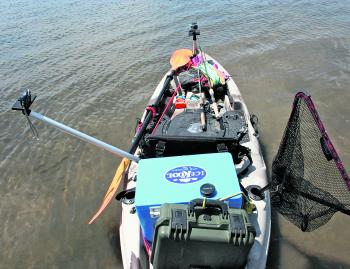
The author's earlier setup with a Camera Boom 150 and Camera Boom 600.
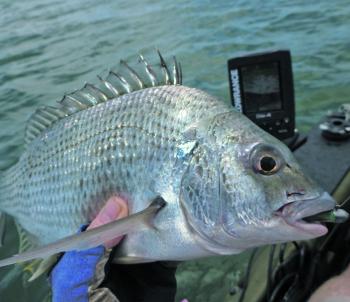
The classic handful of fish shot. Surely there is a better way!
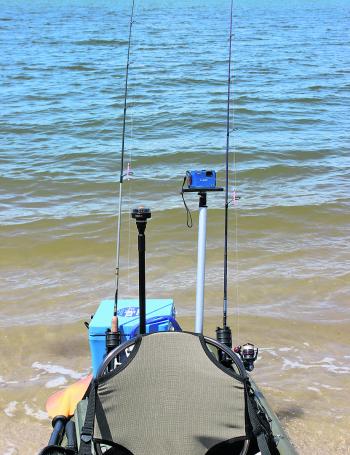
TelePole 1000 with light and Camera Boom 600 with compact camera.
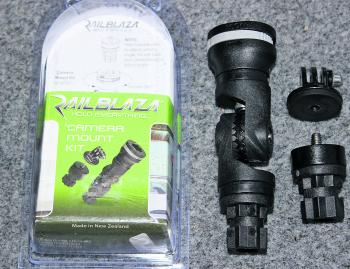
The Railblaza Camera Mounting Kit, including sports camera mount.

The video camera and compact camera ready to record some live action.
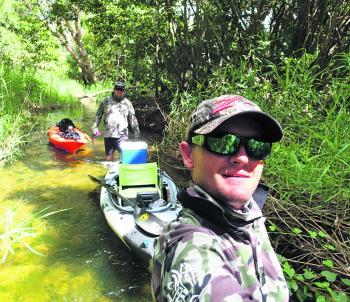
Vinnie Versfeld takes an adventure selfie.
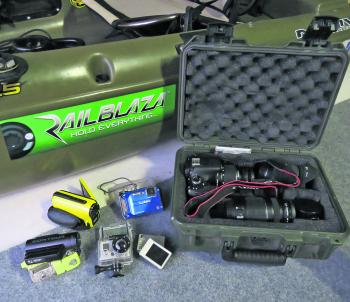
This little collection is worth its weight in gold in terms of the fantastic recording to be captured. Each has its own purpose and when combined will give you a stack of awesome footage!




